Germans wanted coal in their Christmas stockings in Occupied Germany - 1945 to 1949
Dec 26, 2014 22:02:47 #
Although cigarettes seemed to be the most valuable currency in Occupied Germany between 1945 and 1949, the hardest to find commodity was coal. The attached photos show children and women engaged in "fringsen," grabbing a few handfulls of coal briquettes (shaped like walnuts, eggs or bricks) from a truck when it stopped in traffic or parked, then running off. During the early postwar years, there was no coal allowed for use in residential heating, cooking or bathing.
Coal was also on the minds of the Military Government leaders. The Ruhr coal mining area had 140 mines, each with one to seven shafts. Before the war, they produced more than 127 million metric tons of coal per year. In 1946, they produced only 40 million metric tons, a third of the pre-war output. Why so little?
First, in 1938 there were 228,813 miners, and each man produced 1.97 metric tons per shift. In 1946, only 183,186 Ruhr miners remained, and each produced less than half as much coal per shift. Second, during the war the mining machinery was run ragged and not maintained properly. Third, younger miners, 21 to 35, were drafted and replaced with slave workers (who fled the mines when they were liberated), leading to a shortage of skilled miners. Fourth, morale sank as miners believed increased production merely meant greater export while their fellow Germans suffered in the cold.
The Allies rationed food in Germany, allowing only 1,275 calories per day per person. This was misleading, since the food often was not readily available. It was up to the Germans to find it.
But coal mining was tough labor and absolutely vital to the Allies, who also needed it, so a food adjustment had to be made. A daily ration of 2,800 calories was approved for miners in the early months of 1945, then increased to 3,400 calories in late 1945, reduced to 2,900 calories in March 1946, then raised again to 3,400 calories daily in June 1946 --- and finally hiked to 4,000 calories per day in October 1946. But a persistent food shortage brought it back down to 3,600 calories in March 1947.
However, the men still didn't seem as well fed as they should have been. It turned out they were sharing their extra rations with their family members who were on the low-calorie ration cards.
The morale problems were overcome with the June 1948 Currency Reform, introducing the Deutschemark as well as a 20 percent miner pay increase (with money that meant something), and provision of CARE packages, items from German army stocks, bacon, coffee, UNNRA clothing, etc. The Marshall Plan provided about 62 percent of technical investment needed so the mine operators could purchase several million dollars worth of new American mining machinery. Working conditions and production efficiency improved.
The winter of 1949/1950 was the first one in postwar Germany in which demand for both domestic consumption and export of coal was more than met by production. Europe was warm again.
Coal was also on the minds of the Military Government leaders. The Ruhr coal mining area had 140 mines, each with one to seven shafts. Before the war, they produced more than 127 million metric tons of coal per year. In 1946, they produced only 40 million metric tons, a third of the pre-war output. Why so little?
First, in 1938 there were 228,813 miners, and each man produced 1.97 metric tons per shift. In 1946, only 183,186 Ruhr miners remained, and each produced less than half as much coal per shift. Second, during the war the mining machinery was run ragged and not maintained properly. Third, younger miners, 21 to 35, were drafted and replaced with slave workers (who fled the mines when they were liberated), leading to a shortage of skilled miners. Fourth, morale sank as miners believed increased production merely meant greater export while their fellow Germans suffered in the cold.
The Allies rationed food in Germany, allowing only 1,275 calories per day per person. This was misleading, since the food often was not readily available. It was up to the Germans to find it.
But coal mining was tough labor and absolutely vital to the Allies, who also needed it, so a food adjustment had to be made. A daily ration of 2,800 calories was approved for miners in the early months of 1945, then increased to 3,400 calories in late 1945, reduced to 2,900 calories in March 1946, then raised again to 3,400 calories daily in June 1946 --- and finally hiked to 4,000 calories per day in October 1946. But a persistent food shortage brought it back down to 3,600 calories in March 1947.
However, the men still didn't seem as well fed as they should have been. It turned out they were sharing their extra rations with their family members who were on the low-calorie ration cards.
The morale problems were overcome with the June 1948 Currency Reform, introducing the Deutschemark as well as a 20 percent miner pay increase (with money that meant something), and provision of CARE packages, items from German army stocks, bacon, coffee, UNNRA clothing, etc. The Marshall Plan provided about 62 percent of technical investment needed so the mine operators could purchase several million dollars worth of new American mining machinery. Working conditions and production efficiency improved.
The winter of 1949/1950 was the first one in postwar Germany in which demand for both domestic consumption and export of coal was more than met by production. Europe was warm again.
German boys stealing coal in Occupied Germany - Winter 1946/1947
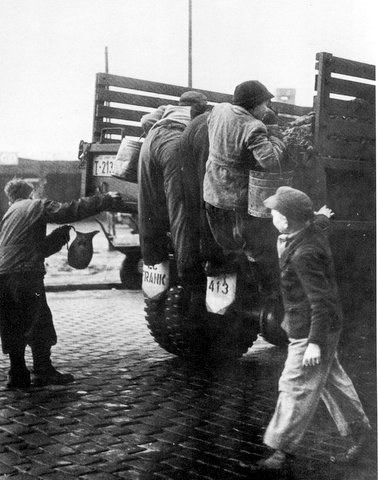
Housewives scavenging coal briquettes - 1946/1947
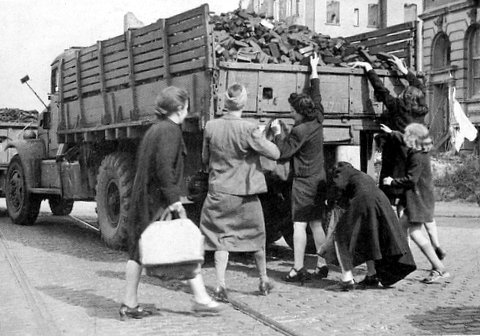
Some women collected fallen branches as fuel in bitter winter of 1946/1947
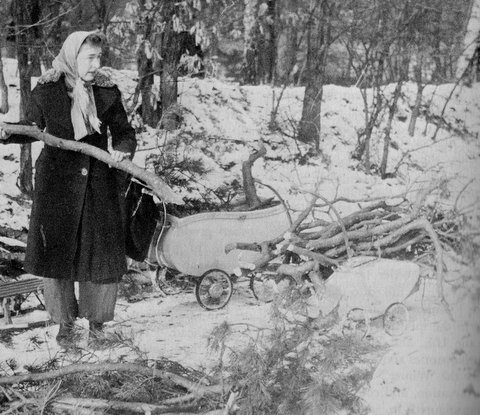
This food represents a full day's ration of 1,275 calories in 1946
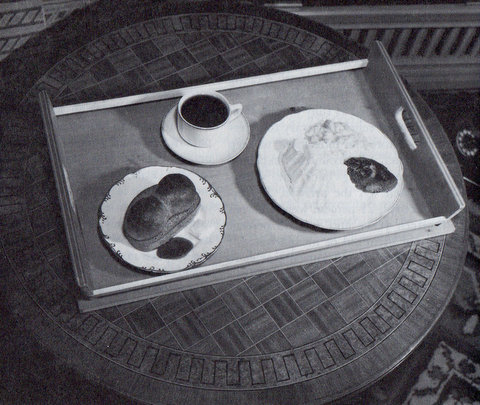
Dec 26, 2014 22:33:11 #
Thanks for producing and sharing this episode Richard...appreciate your efforts. :thumbup: :thumbup: :thumbup:
Dec 26, 2014 22:50:41 #
jederick wrote:
Thanks for producing and sharing this episode Richard...appreciate your efforts. :thumbup: :thumbup: :thumbup:
You're welcome, jedrick. I appreciate your interest and comments. I wasn't sure this would interest the folks following these vignettes, but we'll see.
Dec 27, 2014 05:22:16 #
Dec 27, 2014 09:39:19 #
Living on the German economy in 55 We used coal brickets in 3 stoves we had in the apartment. USA Retired
Dec 27, 2014 13:39:30 #
The Dutch lived on about 400 to 500 calories per day when they could find it. They often ate tulip bulbs.
Dec 27, 2014 14:43:06 #
A member of the US Army during the Occupation of Germany, I remember the terrible winter of '46|'47 spent in Weinheim an der Bergstrasse, near Heidelberg and Mannheim, Germany.
I think the coal shortage was predominantly in the larger cities, because my German War Bride, to whom I showed your message, remembers having coal briquets to use in their kitchen stove. Coal was too heavy and impractical for their small apartment kitchen. Also, like the picture shows, she and other members of her family collected wood year-round...mostly downed tree branches...in the nearby Odenwald ( forest.)
A thousand thanks for this very interesting information.
I think the coal shortage was predominantly in the larger cities, because my German War Bride, to whom I showed your message, remembers having coal briquets to use in their kitchen stove. Coal was too heavy and impractical for their small apartment kitchen. Also, like the picture shows, she and other members of her family collected wood year-round...mostly downed tree branches...in the nearby Odenwald ( forest.)
A thousand thanks for this very interesting information.
Dec 27, 2014 17:01:48 #
Leicaflex wrote:
Very interesting - Thank you for sharing.
Thank you for your interest and feedback, Leicaflex.
Dec 27, 2014 17:28:02 #
warrior wrote:
Living on the German economy in 55 We used coal brickets in 3 stoves we had in the apartment. USA Retired
Thanks for your feedback, Warrior. When I arrived at Fürstenfeldbruck AAF Repple-Depple in December, 1945, I was impressed by the icy cold in the unheated barracks in which "casuals" (unassigned troops passing through) were billeted. We wore several layers of uniform, including the woolen "long-johns." Fortunately, a Red Cross coffee shop was nearby and had heat, plus free hot coffee and doughnuts. I wangled assignment to Permanent Party (PP) status on base and landed in a warm central-heated room with four other guys for a year. We shared a bath (I think it had four johns, basins, and showers) with an adjoining room. These were former quarters of Luftwaffe personnel and a lot better than any AAF billets we had back home. I never saw the coal which I'm sure was being delivered to the base heating plant.
Pvt. RichardQ as a "casual" at FFB airbase - early Dec. 1945
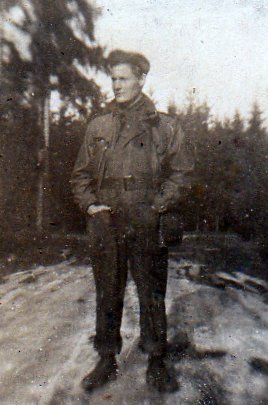
Dec 27, 2014 18:02:09 #
BenVanDyk wrote:
The Dutch lived on about 400 to 500 calories per day when they could find it. They often ate tulip bulbs.
Thank you for your comments and feedback, Ben. The terrible Nazi occupation of Holland was fading on April 28, 1945 when the American Eighth Air Force's first humanitarian missions,"Operation Chowhound," began to drop food to the starving Dutch. Together with the RAF (who called their operation "Manna"), they flew 5,300 sorties and dropped just over 12,000 tons of food by the time the missions ended on May 8, 1945. One B-17 went down over the North Sea; two crew members survived, ten aboard died.
There was no way the U.S. Army was going to impose the same harsh food restrictions on the Germans as those imposed on Holland by the Nazis. But neither would they ration them more than was available in the neighboring countries. Col. Frank Howley, Deputy Military Governor of Berlin, was called on the carpet by Gen. Lucius Clay and asked, "Are the people of Berlin starving?" Howley answered, "If by starving, you mean that they are losing weight, yes. If you mean that they are dying from lack of food, no."
Then Clay asked, "How about the part of the report that says they are foraging for acorns?" Howley responded, "The people of France used acorns to make ersatz coffee during the Nazi occupation. And the Germans...use acorns for pudding, and horse chestnuts for making bread. That still doesn't mean that anyone is starving. City records don't show a single case of death from starvation."
Dec 27, 2014 18:18:27 #
Jackel wrote:
A member of the US Army during the Occupation of G... (show quote)
Thank you for your feedback and interest, Jackel. Perhaps your wife's family benefitted from the availability of coal to the American military families and offices located off-post in Heidelberg and environs, since there was bound to be some "diversion" during deliveries. From Oct. 1947 to Sept. 1948, I lived in a one-room bedroom in Frankfurt while employed as a civilian by the Adjutant General's Office. There was a small pot-bellied stove in a corner of the room which was fueled by coal. The scuttle was filled by the building's concierge (a married couple who monitored the comings and goings). My room was actually part of a former apartment, but each room was now occupied by separate tenants who shared the bathroom, so I guess the others also had a separate little coal-fired heater.
The bulk of the coal production went to the electric power plants, as well as to the various military posts.
Dec 27, 2014 22:54:54 #
Dec 27, 2014 23:39:50 #
Thanks for this. the younger folks today have no concept of the horror and devastation and deprivation the world saw in 1939-1945 and continued for a few years after.
I always thought there were a few movies everyone should see - Schindler's List and Saving Private Ryan just for starters. Looks like the newly released "Unbroken" might be added to those. Whatever historical inaccuracies there might be are far outweighed by the message contained within. I was shot at in VietNam, but it was nothing like the first 20 minutes or so of Saving Private Ryan, which, from all accounts, was pretty accurate.
I always thought there were a few movies everyone should see - Schindler's List and Saving Private Ryan just for starters. Looks like the newly released "Unbroken" might be added to those. Whatever historical inaccuracies there might be are far outweighed by the message contained within. I was shot at in VietNam, but it was nothing like the first 20 minutes or so of Saving Private Ryan, which, from all accounts, was pretty accurate.
Dec 27, 2014 23:44:15 #
MTG44 wrote:
Thanks again for wonderful history lesson. Keep them coming.
You're welcome, MTG. I plan to keep on scribbling these vignettes as long as I'm able (or until the UHH admin pulls my plug). You have no idea how much stuff is lurking behind the curtains of the Military Occupation's four years. But I don't plan to cover the rest of our years in Germany.
Dec 28, 2014 00:35:11 #
I am also Vietnam Era. and have many friends that tasted the conditions of a police action .... Your stories or memories from that time are those that people like my self have read in story book and I am not sure how much has been embellished to the point that there is little left to believe. I like what you are doing please continue.
DGB/USAF/42 BOMB WING SAC
DGB/USAF/42 BOMB WING SAC
If you want to reply, then register here. Registration is free and your account is created instantly, so you can post right away.







